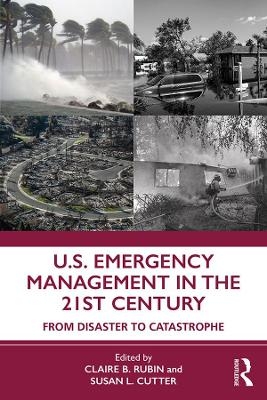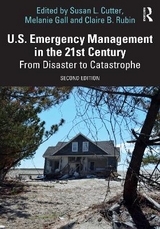
U.S. Emergency Management in the 21st Century
Routledge (Verlag)
978-1-138-35466-1 (ISBN)
- Lieferbar
- Versandkostenfrei
- Auch auf Rechnung
- Artikel merken
U.S. Emergency Management in the 21st Century: From Disaster to Catastrophe explores a critical issue in American public policy: Are the current public sector emergency management systems sufficient to handle future disasters given the environmental and social changes underway? In this timely book, Claire B. Rubin and Susan L. Cutter focus on disaster recovery efforts, community resilience, and public policy issues of related to recent disasters and what they portend for the future.
Beginning with the external societal forces influencing shifts in policy and practice, the next six chapters provide in-depth accounts of recent disasters— the Joplin, Tuscaloosa-Birmingham, and Moore tornadoes, Hurricanes Sandy, Harvey, Irma, Maria, and the California wildfires. The book concludes with a chapter on loss accounting and a summary chapter on what has gone right, what has gone wrong, and why the federal government may no longer be a reliable partner in emergency management.
Accessible and clearly written by authorities in a wide-range of related fields with local experiences, this book offers a rich array of case studies and describes their significance in shifting emergency management policy and practice, in the United States during the past decade. Through a careful blending of contextual analysis and practical information, this book is essential reading for students, an interested public, and professionals alike.
Claire B. Rubin has more than 40 years of experience in the field of emergency management, having worked as an independent researcher, academic, practitioner, and consultant. As a consultant, she has worked for many organizations — private, non-profit and government. Her work includes basic and applied research; the development and presentation of training programs; and the creation and operation of various information dissemination and utilization projects. From 1998-2014, Ms. Rubin was affiliated with the Institute for Crisis, Disaster, and Risk Management at The George Washington University in Washington, D.C.; she was a research associate and adjunct faculty member there. For the past nine years, she has maintained the blog RecoveryDiva.com. She has published about 100 articles and given many lectures at professional conferences. Rubin is the co-founder and former Managing Editor of The Journal of Homeland Security and Emergency Management, which is now in its 14th year of publication. Susan L. Cutter is Carolina Distinguished Professor of Geography at the University of South Carolina and director of the Hazards & Vulnerability Research Institute. She is a nationally and internationally recognized scholar publishing more than 14 books and 175 refereed articles and book chapters. Her primary research interests are in the area of vulnerability and resilience science and how they influence place-based differences in disaster recovery. Cutter is an elected fellow of the American Association for the Advancement of Science (AAAS) and a former president of the American Association of Geographers (AAG) and the Consortium of Social Science Associations (COSSA). She served on many national advisory boards and committees, including those of the National Academies of Science, Engineering, and Medicine, National Institute of Standards and Technology, the National Science Foundation, and was a juror for the Rebuild by Design competition for Hurricane Sandy Recovery Projects. She also is an elected a foreign member of the Royal Norwegian Society of Science and Letters. She received her master’s and doctorate in geography from the University of Chicago.
1. Introduction 2. Tipping Points in Policy and Practice 3. As Tornado Outbreaks Become More Deadly, Major Changes Happen 4. Hurricane Sandy: The New York City Experience 5. Hurricane Harvey: Issues for Urban Development 6. Hurricane Irma and Cascading Impacts 7. California Wildfires 8. Hurricane Maria: Fragile Settings and Catastrophic Destruction 9. Loss Reduction and Sustainability 10. Summary and Looking Backward and Forward
| Erscheinungsdatum | 09.12.2019 |
|---|---|
| Zusatzinfo | 10 Tables, black and white |
| Verlagsort | London |
| Sprache | englisch |
| Maße | 152 x 229 mm |
| Gewicht | 900 g |
| Themenwelt | Naturwissenschaften ► Biologie ► Ökologie / Naturschutz |
| Naturwissenschaften ► Geowissenschaften ► Geografie / Kartografie | |
| Sozialwissenschaften ► Politik / Verwaltung ► Europäische / Internationale Politik | |
| ISBN-10 | 1-138-35466-X / 113835466X |
| ISBN-13 | 978-1-138-35466-1 / 9781138354661 |
| Zustand | Neuware |
| Haben Sie eine Frage zum Produkt? |
aus dem Bereich



